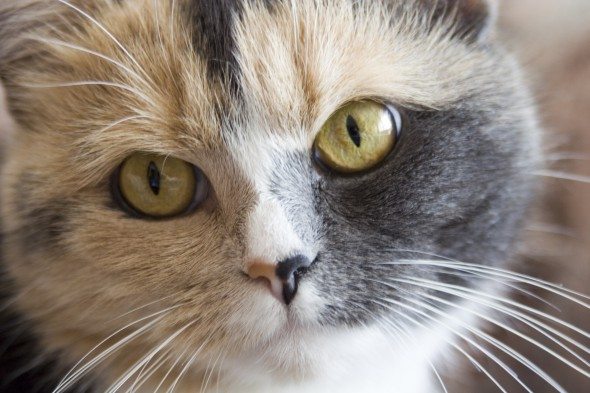Everyone knows that whiskers are one the of cutest features on cats, but did you know that they serve a very specific function in your cat’s well-being?
Whiskers are unlike human hair or even the rest of your cat’s fur. They are especially thick and embedded deeply in the cat’s body. They connect directly to muscular and nervous system, which makes them extremely sensitive, sending a signal throughout the cat’s body to alert them of even slight changes in air currents.
Whiskers are used to sense distance between the cat and objects surrounding them, helping to prevents head bumps on the wall, etc. They’re also used to help the cat know if he can fit in to small spaces. The whiskers are usually as broad as the cat is wide, so if the whiskers can fit into a small space without being pushed down then the cat should fit. The whisker check doesn’t necessarily work if the cat is overweight. Of course, when it comes to cardboard boxes cat’s don’t seem to have any qualms about whether they can fit, they will make it happen.
The whiskers above the cat’s eyes, kind of like eyebrows, help your cat especially when hunting. Touching these whiskers will trigger a blink reaction which protects kitty’s eyes from branches, leaves, or other animals.
There are also whiskers on the backside of cat’s wrist which aid in hunting. The whiskers tell the cat if their prey is moving. And using these senses, the cat can adjust his hold on prey until he’s able to deliver a swift kill.
Observing whisker movement is one of the indicators to understand your cat’s mood. Since the whiskers detect changes in air currents, forward facing whiskers indicate your cat is hunting or sensing the environment. If whiskers are pushed back against their face it indicates your cat is preparing for battle and doesn’t want their whiskers to get damaged. Whiskers hanging loosely down means your cat is comfortable and relaxed. My cats like to be unpredictable, so remember whisker position is not the only indicator of kitty’s mood, look for all signs if you want to know what your cat’s thinking.
Children should be told from a very young age to not mess with cat whiskers. The whiskers are very sensitive and if damaged it could cause pain and trauma for your cat. Children are much more likely to cut a cat’s whiskers if curious and given the chance. If your cat’s whiskers are cut, you can expect to see scared and disoriented behavior. Your cat may also bump into things a lot. Don’t expect a lot of play, most will spend their time laying until the whiskers grow back to a normal length. Even if the whiskers aren’t cut, cats do not like their whiskers played with because it confuses their senses. If cat’s whiskers are disturbed regularly your cat may start to behave aggressively when people are near his face, which is definitely undesirable behavior. Just remember, even if it’s funny to play with your cat’s whiskers while he’s asleep, whiskers aren’t toys.
If your cat’s whiskers become damaged naturally and are only slightly bent you need not worry. They may not straighten back out, but whiskers fall out over time and regrow. As long as they’re still wider than your cat’s face you should still see normal behavior. You may find whiskers around the house as they fall out, they’re very sharp and may feel needle-like if stepped on. Giving your cat exclusive places for him to scratch his face should help contain the whisker-needles, as cats will aid the natural process by scratching their faces on objects. Cats also have a large number of sensory receptors in the cheeks so it’s a real treat for them to rub their faces on everything.
Cat are wonderful pets and if you have one or intend to get one it’s best to know everything you can about your furry buddy.
Michelle Falk-Nixon












Speak Your Mind